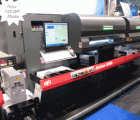
Drupa saw the launch of the 3.2m Vutek HS100 Pro, which the company says is set to become a screen print replacement with image quality approaching offset. Driven by EFI’s Orion software and the Fiery proServer, the HS100 Pro has high throughput rates, low ink consumption and a pin curing system which the company says guarantees precise droplet placement.
The Vutek QS2 Pro is also being launched at the show, targeting the mid-range two metre wide sector, with six-colours plus three layers of white, and low print cost which EFI says doesn’t compromise colour quality. Both machines have variable drop greyscale print heads, EFI’s advanced ink formulation and low total cost of ownership.
EFI says its Orion OS is a robust, integrated operating system specifically engineered to maximise the capabilities of every new EFI wide format and Vutek inkjet printing system. Orion OS contains a set of expandable features that the company says optimise printer technology and functionality. It controls a combination of software and hardware that work together to provide greyscale readiness, remote assistance, enhanced colour, integration and improved performance.
The company says its new Jetrion 4900 has brought print-and-cut capabilities to label convertors in a fully integrated narrow-web digital press that caters to shorter runs and greater levels of flexibility. This digital label production machine features CMYK and an opaque white ink, plus laser cutting, resulting in a complete production line that’s ideal for the lean manufacturing of high-quality durable labels on a wide variety of substrates.
Fiery digital front-ends continue to provide support for VDP. Visitors to the EFI stand have seen Fiery server with HyperRIP technology, which EFI says reduces processing times by up to 40 per cent. Running the latest VDP standard, PPML 3.0, Fiery technology demonstrations include new workflow automation, advanced job make-ready software, and new voice activated commands that remotely control the Fiery as well as the digital engine attached to it. Also on show is Fiery’s support for the new Altona Test Suite 2.0 and advanced colour profiling and spot colour solutions.
EFI’s MIS and web-to-print products are designed to simplify operations for a more streamlined workflow and intelligent automation. At drupa, it is showing the latest versions of the browser-based EFI Pace and EFI PrintSmith Vision, EFI Monarch and EFI Radius. Also working, the latest version of the EFI Digital StoreFront web-to-print platform will also be shown, with integration to Fiery technology.
During the show, EFI has announced cloud-based remote data protection offerings for Print MIS and web-to-print customers. Its cloud service offering of off-site data protection services utilises its own data centre in North America and additional sites in Europe. Available now, EFI is offering new online back-up, storage and data recovery options for Print MIS and web-to-print customers that wish to host their own solutions, to ensure protection, redundancy and speedy recovery in case of disaster. Operations are monitored continuously and customers are notified immediately of conditions that could impact service.
Ghilad Dziesietnik, chief technology officer of EFI, says, “EFI has been a pioneer in cloud-based services with active customers since 2000. We are the largest managed services provider for print providers, with thousands of locations and millions of users accessing the cloud. Software in the cloud offers numerous benefits, most notably reduced maintenance costs for users, 24/7 care and management by a team of experts, anywhere access to information, redundancy, back-up and highly secure data. Our new remote data protection services provide many of these advantages for clients that wish to host their own applications.”
EFI’s current cloud-based Software as a Service offerings include EFI Pace and EFI PrintSmith Vision management systems, the EFI Digital StoreFront web-to-print platform, and the new EFI Fiery Dashboard business information service. EFI says its applications were designed from the ground up to run in a browser adding that their performance and reliability have been fine-tuned over the years to work optimally in a cloud-based deployment.
Comment below to have your say on this story.
If you have a news story or tip-off, get in touch at editorial@sprinter.com.au.
Sign up to the Sprinter newsletter



